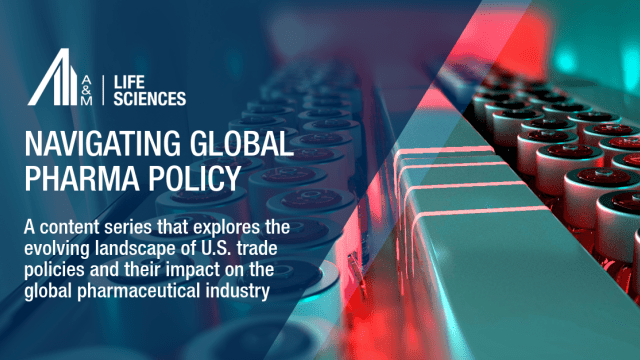JP Morgan Healthcare Conference Recap
The JP Morgan Healthcare Conference 2025 offered a comprehensive view of the trends, challenges, and opportunities shaping the biopharma and healthcare landscape. This year's event highlighted the growing influence of AI in R&D, a cautious but intriguing M&A climate, and the need for innovation in digital health and consumer empowerment. From NVIDIA's game-changing partnerships to the continued rise of Chinese biotech, the conference underscored the industry's dynamic shifts as we move into the new year. In this blog, we explore the key takeaways, offering insights into how stakeholders can leverage these developments for success.
AI to ROI
As we look to 2025, the question arises: Will this be the year that Artificial Intelligence (AI) drives substantial improvements in R&D productivity within the biopharma sector? The FDA's recent release of draft guidance on utilizing AI for regulatory decision-making marks a pivotal advancement, offering a framework for biopharma companies to seamlessly integrate AI technologies into their regulatory submissions and data packages. At JPM, NVIDIA's strategic partnerships with industry leaders such as IQVIA, Illumina, and Mayo Clinic were announced, aiming to expedite the application of AI in healthcare. AI promises to revolutionize drug development by refining target identification, optimizing molecule design, and enhancing clinical trial processes. However, to fully capitalize on these opportunities, sponsors must address critical challenges related to data integrity, regulatory compliance, and other operational hurdles.
Fewer Deals Announced in 2025
JPM is always a New Year’s bellwether for business development activities. Despite the belief that 2025 will see a rise in M&A activity, this year's conference saw less deal activity (8 deals) from the top 20 global pharma companies compared to last year’s conference (13 deals). Digging deeper into the deals reveals some interesting insights. Despite Oncology being the most attractive TA for investments in both years, the combined value of Neuroscience deals was worth more. Also, all lead assets acquired in 2025 were small molecules whereas 2024 had an even mix between small molecules and innovative modalities. Will deal activity in 2025 surpass last year? Most prognosticators say yes, but the year is off to a slow start. Buyers will be selective, so sellers need to differentiate their assets and demonstrate a unique value proposition.
Digital Health
Digital health companies such as Amwell and Teladoc are facing significant pressure to develop and implement profitable business models following a dramatic decline in their stock prices, which have plummeted by more than 90% over the past four years. This downturn reflects broader challenges in the digital health sector, where initial pandemic-driven growth has given way to market skepticism about long-term profitability and sustainability. Investors are increasingly scrutinizing these companies' ability to transition from rapid expansion to sustainable financial performance. To address these concerns, digital health companies are focusing on diversifying their service offerings, enhancing operational efficiencies, and forging strategic partnerships to drive revenue growth. The emphasis is on demonstrating tangible value to both consumers and healthcare providers, as well as proving that their platforms can deliver cost-effective, high-quality care at scale. As these companies navigate this critical juncture, their ability to innovate and adapt will be key to regaining investor confidence and achieving financial stability.
Innovation from China
The rise of Chinese biotech companies is becoming increasingly prominent on the global stage, as evidenced by the significant licensing deals announced at the 2025 JP Morgan Healthcare Conference. Jiangsu Hengrui Pharmaceuticals, a leading Chinese biotech firm, highlighted its global ambitions and strategic plans for further dealmaking, underscoring the growing influence of Chinese innovation in the biopharma sector. This trend is part of a broader movement where Chinese biotechs are becoming preferred partners for U.S. companies, driven by their high-quality science and cost advantages. The conference saw a flurry of activity, with numerous licensing agreements, including AbbVie’s option agreement with Simcere Zaiming, that reflect the increasing collaboration between Chinese and Western biopharma companies, signaling a shift towards a more integrated global biopharma landscape.
Consumer Health Empowerment
The transition from healthcare consumer engagement to consumer empowerment is reshaping the industry, as patients increasingly demand more control over their health decisions and access to affordable care. This shift is facilitated by digital health innovations that provide consumers with unprecedented access to their health data and personalized care options. However, this empowerment comes with the risk of heightened consumer frustration and anger over the persistently high costs of healthcare. The recent murder of UnitedHealthcare CEO Brian Thompson brought these tensions to the forefront, highlighting the volatility in consumer sentiment. As patients become more empowered, their expectations for transparency, affordability, and quality care intensify, placing pressure on all healthcare stakeholders to meet these demands. The intersection of healthcare and business has always been complex, but the life sciences industry must skillfully navigate these new challenges to harness the benefits of consumer empowerment while recognizing the risks associated with consumer dissatisfaction and unrest.





